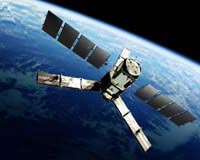 |
Providence RI (SPX) Sep 08, 2009 Outer space offers a new perspective for measuring economic growth, according to new research by three Brown University economists. In a National Bureau of Economic Research working paper, J. Vernon Henderson, Adam Storeygard, and David N. Weil suggest a new framework for estimating a country or region's gross domestic product (GDP) by using satellite images of the area's nighttime lights. Reliable data on economic growth is hard to come by in many parts of the world - particularly in sub-Saharan Africa and other developing countries - and the data is often not calculated at all for cities. The authors cite the Penn World Tables, one of the standard compilations of data on income, which rank countries with grades A through D by the quality of their GDP and price data. While almost all industrialized countries receive a grade of A, nearly all sub-Saharan African countries get a grade of C or D, which is interpreted as roughly 30 or 40 percent margin of error. Several countries do not appear in the table, including Iraq, Myanmar, Somalia, and Liberia. To improve these estimates, Henderson, Storeygard, and Weil suggest combining measured income data with the changes observed in a country's "night lights" as seen from outer space. Using U.S. Air Force weather satellite picture composites, they look at changes in a region's light density over a 10-year period. "Consumption of nearly all goods in the evening requires lights," they write. "As income rises, so does light usage per person, in both consumption activities and many investment activities." When the researchers applied the new methodology to countries with low-quality national income data, the new estimates were significantly different. For example, in the Democratic Republic of Congo, lights suggest a 2.4-percent annual growth rate in GDP, while official estimates suggest a negative 2.6-percent growth over the same time period. The Congo appears to be growing faster than official estimates suggest. At the other end, Myanmar has an official growth rate of 8.6 percent a year, but the lights data imply only a 3.4-percent annual growth rate. Henderson, Storeygard, and Weil say they don't envision the lights density data as a replacement for official numbers, but when added to existing data from agencies like the World Bank, the lights density can provide a better indicator of how these economies really are performing. "Our hope is that people start using this, either when they don't have actual data on economic growth ... or when the numbers are pretty bad," said Henderson, professor of economics. "This is just a way to get better estimates." The second portion of the paper establishes the first known causal relationship between local agriculture productivity and an increase in city incomes. The authors examined 541 cities in 18 African countries over a period of nine years, using rainfall as a way to measure "productivity shocks" to the rural areas. The authors conclude that an increase in agricultural output does in fact have substantial effects on local urban economic activity. Storeygard, a fourth-year graduate student, added that the research was a true collaboration. Weil has written widely on various aspects of economic growth, while Henderson is interested in how to measure growth at a regional or subnational level. Storeygard has experience using geographic and satellite data. "It's the kind of paper that used all three of our areas," said Storeygard. "I don't think any two of us would have been able to do this in quite the same way." Share This Article With Planet Earth
Related Links National Bureau of Economic Research Earth Observation News - Suppiliers, Technology and Application
 SMOS Team Gears Up For Launch Campaign
SMOS Team Gears Up For Launch CampaignParis, France (ESA) Sep 03, 2009 With launch just two months away, members of the SMOS team are currently in Russia inspecting the facilities where the launch campaign will soon get underway to prepare the ESA's water mission for liftoff on 2 November. Members of the team are busy checking the facilities at both Arkhangelsk, where the satellite and support equipment will arrive in Russia by plane, and the integration faci ... read more |
|
| The content herein, unless otherwise known to be public domain, are Copyright 1995-2009 - SpaceDaily. AFP and UPI Wire Stories are copyright Agence France-Presse and United Press International. ESA Portal Reports are copyright European Space Agency. All NASA sourced material is public domain. Additional copyrights may apply in whole or part to other bona fide parties. Advertising does not imply endorsement,agreement or approval of any opinions, statements or information provided by SpaceDaily on any Web page published or hosted by SpaceDaily. Privacy Statement |